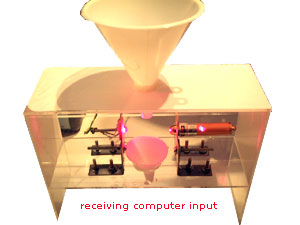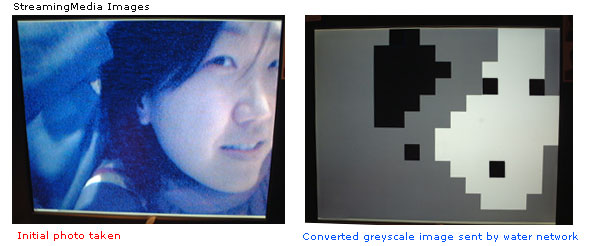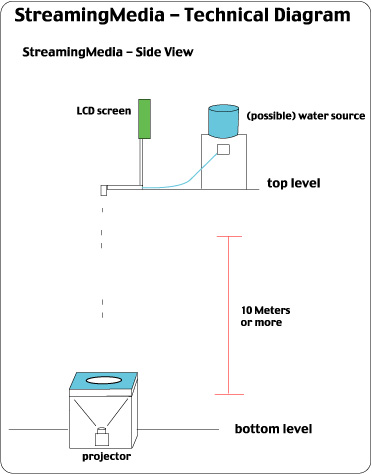
Using water as an organic network between two computers.
 |
 |
Overview
StreamingMedia is an interactive data sculpture that employs a new Internet protocol (H2O/IP) I’m developing that uses water to transmit information between computers. H2O/IP functions in a similar way as TCP/IP but focuses on the inherent viscous properties of water that are not present in traditional packet networks. The StreamingMedia demonstration of H2O/IP is as an installation of two computers at different heights where one captures an image and transmits it to the second computer in the form of modulated water drops.
The project attempts to show how digital information can be encoded and decoded into organic forms to create a physical network between digital devices.
Prototype
Computers and electronic systems rely on networks to communicate and move information from one physical location to the next. These networks exist as both wireless and tethered entities that utilize coded patterns (such as Ethernet’s CSMA/CD protocol) and electronic means to carry their messages. StreamingMedia treats water as a delivery mechanism like any other network protocol to move information across distance. Before connecting, computers have no knowledge of each other’s existence so any type of connective protocol will work as long as the machines have the right inputs and outputs and are configured with software to understand the protocols.
The core technology behind StreamingMedia is a new network protocol I’m developing for water transmission called H2O/IP. H2O/IP functions in a similar way as TCP/IP but focuses on the inherent viscous properties of water that are not present in traditional packet networks. These properties include fluidity, heat index, tri-state properties, density difference depending on state, and surface tension. Based on the OSI (Open Systems Interconnection) Model, H2O/IP exists as a physical layer consisting of custom-designed hardware throughputs, a network layer used to decode incoming and outgoing messages, a transport layer between messages and communication interfaces, and an application layer that allows for connecting infinite input and output mechanisms. Depending on the design of the StreamingMedia network, the data layer can dynamically adjust to each change while maintaining the integrity of the network.
System
The StreamingMedia system will exist in two parts. Ideally both computers are separated by a distance of at least 10 meters in height, such as in a stairwell.
1. The set-up at the top of the stairwell consists of a computer with a flat panel LCD screen and a USB video camera. When someone walks up to the screen they see live video of themselves. There is a button in front of the screen that when pressed takes a picture of the person. The picture is then translated into a 16 x 16 pixel grayscale image (desktop icon size) and displayed on the LCD.
Also upstairs is a water valve attached to a fixed jug of water or connection to a water source/main. When the grayscale image is created, the computer then analyzes the color of each pixel and ‘prints’ out pulses to the electronically controlled water valve – a different pulse pattern depending on the color of the pixel on screen. The water then falls to the first floor.
2. The set-up on the first floor consists of a plexi-glass tray that awaits the falling water drops. The tray will sit on top of a custom built wooden box with a video projector inside. A funnel situated above an infrared switch watches for falling drops and through a microcontroller, feeds information to the computer at the bottom to decode which color pixel has been printed.
Here is a model of the installed setup:
Credits: |
OverviewStreamingMedia is an interactive data sculpture that employs a new Internet protocol (H2O/IP) I’m developing that uses water to transmit information between computers. H2O/IP functions in a similar way as TCP/IP but focuses on the inherent viscous properties of water that are not present in traditional packet networks. The StreamingMedia demonstration of H2O/IP is as an installation of two computers at different heights where one captures an image and transmits it to the second computer in the form of modulated water drops. |
Press/Media The Guardian: Streaming audio using water (and other radio hacks), By Andrew Orlowski, 12/9/03. Neural: StreamingMedia: electronic art with IP and water – 1/4/03. VUNET: Water Way To Run a Network – 1/3/03. TF1: Quand l’eau sert de reseau 1/5/03. SlashDot: H20/IP – 1/30/02 |
![]()





